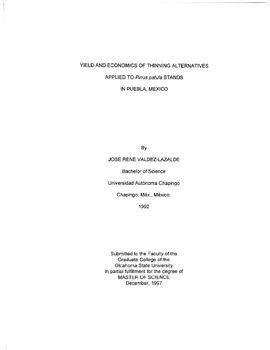| dc.contributor.author | Valdez-Lazalde, Jose Rene | |
| dc.date.accessioned | 2014-09-29T19:41:38Z | |
| dc.date.available | 2014-09-29T19:41:38Z | |
| dc.date.issued | 1997-12-01 | |
| dc.identifier.uri | https://hdl.handle.net/11244/12405 | |
| dc.description.abstract | Economic evaluation of forest management alternatives is essential to determine the most appropriate silvicultural management regimes to follow when managing a stand or a forest. This is particularly true when the forest owner's main goal is to maximize all future net revenues resulting from a forest production process. Such gains can be accounted in terms of utility, satisfaction, or in monetary units. Because some combinations of silvicultural practices applied to a stand may result in better economic gains that common practice forest management, any new management strategy must be evaluated under economic criteria (Solberg, 1991). | |
| dc.format | application/pdf | |
| dc.language | en_US | |
| dc.publisher | Oklahoma State University | |
| dc.rights | Copyright is held by the author who has granted the Oklahoma State University Library the non-exclusive right to share this material in its institutional repository. Contact Digital Library Services at lib-dls@okstate.edu or 405-744-9161 for the permission policy on the use, reproduction or distribution of this material. | |
| dc.title | Yield and Economics of Thinning Alternatives Applied to Pinus Patula Stands in Puebla, Mexico | |
| dc.type | text | |
| osu.filename | Thesis-1997-V145y.pdf | |
| osu.accesstype | Open Access | |
| dc.type.genre | Thesis | |
